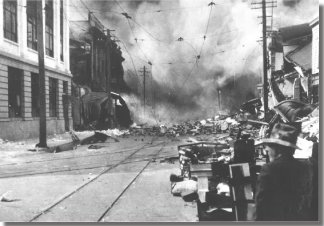Our history
Natural Hazards Commission Toka Tū Ake (formerly EQC) is New Zealand’s natural hazards insurance scheme. There have been several changes to the scheme since it began, all in support of our mission to reduce the impact on people and property when natural disasters occur.
The creation of our natural hazard insurance scheme
The first version of our scheme was set up in 1945 to provide affordable insurance to help communities recover from natural disasters. Until that time, only war insurance was compulsory and as a result few people insured themselves against earthquakes and other natural hazards – despite a history of such events (including the 1931 Napier earthquake, New Zealand’s worst natural hazard event in terms of lives lost).

Napier earthquake 1931
In 1942, major earthquakes shook the Wairarapa region of the North Island, and devastated communities. With many uninsured homeowners still struggling to recover several years later, the organisation that began as the War Damage Commission was extended to cover earthquake risk and renamed the Earthquake and War Damage Commission in 1945. The scheme in its original form was funded by a levy placed on all fire insurance policies.
Changes to our legislation
Our scheme continued in much the same way for almost 50 years through significant earthquakes, tsunami and landslides, until 1993.
Notable exceptions were changes to our founding legislation in 1984 and 1988.
The 1984 amendment included insurance cover for residential land against natural disaster damage – a need that arose from the landslide in the Dunedin suburb of Abbotsford in 1979, when 69 homes were destroyed.
The 1988 amendment gave us the power to act commercially and handed over control and responsibility for our fund – at that time called the Natural Disaster Fund – to us.
In 1993, a new act (the Earthquake Commission Act 1993) passed and we became the Earthquake Commission (EQC).
This new act marked the most significant change to New Zealand’s natural disaster insurance since the original 1944 legislation, including among other things, removing the cover for commercial properties and a greater remit for research into natural hazards and natural hazard mitigation – now a core pillar of our work.
This was followed over the years, by a number of legislative reviews, resulting in changes such as an extension of timeframes for lodging a claim, an increase in the cap to $150,000 (from $100,000) and the removal of household contents cover.
Natural hazard events that have shaped us
In the years since the introduction of the EQC Act 1993, New Zealand experienced several significant natural hazard events.
These events resulted in widespread damage to communities across the country, and shaped the way we operate.
Among them, eruptions of Mt Ruapehu in 1995 and 1996; significant earthquakes in 2007 (Gisborne), 2013 (Cook Strait), 2014 (Eketahuna), and 2016 (Christchurch and Kaikoura); flooding and landslips in Whanganui in 2015, Edgecumbe in 2017, and across the country in 2018; and major weather events in Nelson and Marlborough in 2022, and the upper North Island in 2023.
The period also included the Canterbury earthquakes of 2010 and 2011 which destroyed large parts of the city and resulted in the deaths of 185 people. These events prompted the Public Inquiry into the Earthquake Commission, which was completed in 2020.
The next chapter: a new model, new legislation and a new name
Since 2020, there have been two significant milestones for the organisation.
In 2021, we formed a partnership with a number of Aotearoa New Zealand’s private insurers. The insurer partnership sets up an agreement for private insurers to manage natural hazards cover claims on our behalf. This streamlines customer response by giving homeowners a key point of contact for their insurance claim, including the natural hazards cover portion, through their private insurer.
More recently, in 2023, the government approved our new governing legislation – the Natural Hazards Insurance Act 2023 – which came into effect on 1 July 2024.
The Natural Hazards Insurance Act modernises and replaces the Earthquake Commission Act 1993, and takes into account lessons learnt from the Canterbury earthquake sequence, the Kaikōura earthquake, and other natural hazard events, as well as the Public Inquiry into the Earthquake Commission completed in 2020.
The Act also changed our name, and we are now known as the Natural Hazards Commission Toka Tū Ake, in recognition of the fact our scope extends to delivering insurance and expertise for a range of natural hazards – not just earthquakes. This has resulted in changes to the names of both our insurance product EQCover, now known as NHCover, as well as the Natural Disaster Fund, now the Natural Hazard Fund.